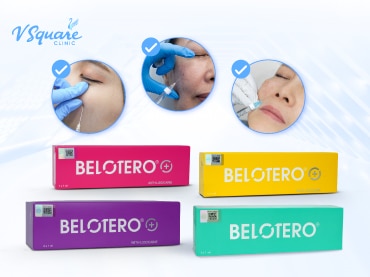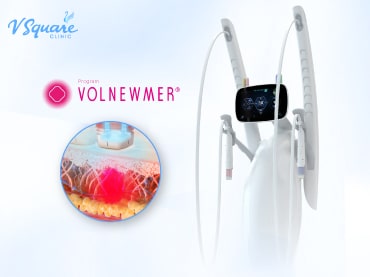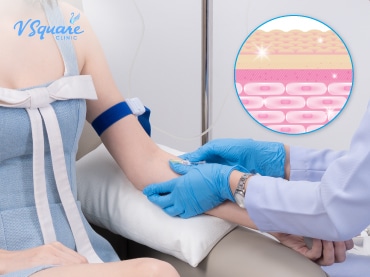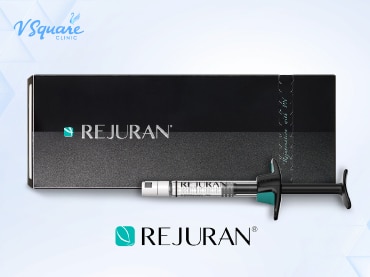An in-depth look at the thread lifting procedure
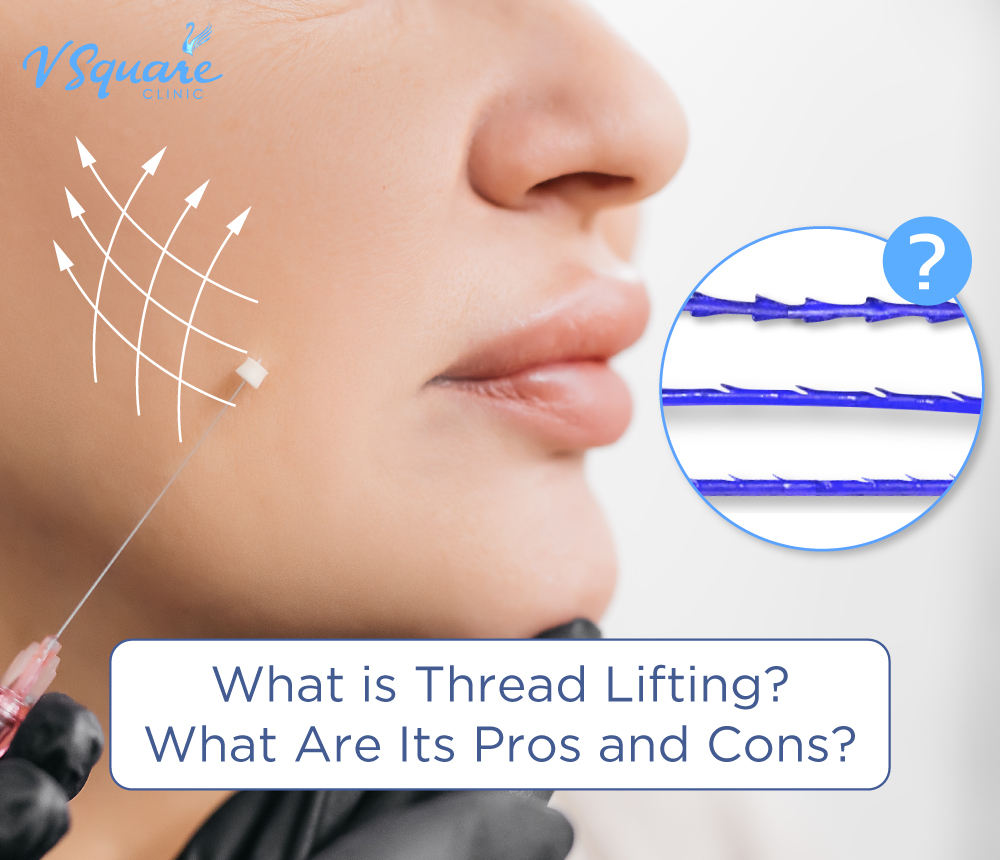
Thread lifting is a minimally invasive procedure where dissolvable threads with barbs are inserted into the skin using fine needles. As the threads are placed, the barbs hook onto the skin and gently pull it upward in the direction of the insertion, similar to how a fishhook lifts. This technique can be used for facial contouring, lifting sagging skin, tightening loose areas, reshaping the nose, and even lifting the outer corners of the eyes.
This article explores the procedure steps, pros and cons, potential side effects, and how to select the most suitable type of thread based on your facial structure.
If you’re considering where to get a thread lift, this guide will help you make an informed decision.
Table of Content : Thread Lifting
What Can Thread Lifting Help With?
Thread lifting is a well-known and popular non-surgical procedure that can improve various facial concerns, such as:
- Slimming and contouring the face
- Lifting sagging cheeks and enhancing facial structure
- Enhancing the nose without surgery (Thread Nose Lift)
- Lifting drooping eyelids and outer eye corners (Foxy Eye Lift)
- Reducing fine lines and stimulating collagen production under the skin
Who Is a Good Candidate for Thread Lifting?
Thread lifting is suitable for individuals who want to lift and tighten their face, improve facial contours, correct sagging cheeks, drooping brows or eyes, and reshape the nose—without surgery and with fast, visible results.

During a thread lift, threads are anchored at the temples and pulled upward from the lower cheeks to lift sagging skin instantly.
The threads stimulate collagen production and improve blood circulation, leading to firmer, tighter skin.
Thread lifts can also be combined with filler, Botox, or HIFU for enhanced results. Consult your physician for a personalized treatment plan.
Is Thread Lifting Safe?
Thread lifting is safe when performed correctly using FDA-approved dissolvable threads and under the care of an experienced physician.
On average, thread lifts support the skin for 4 to 12 months, depending on the type of threads used. Once dissolved, the threads leave behind natural elastin fibers, which help maintain skin firmness, similar to the body’s connective tissue.
What Are the Possible Side Effects of Thread Lifting?
Common and temporary side effects:
- Mild swelling or bruising, which typically resolves within 7–14 days
- A slight sensation of threads under the skin during facial movements
- Minor bleeding at needle entry points
Serious but avoidable complications:
- Thread migration or breakage
- Inflammation or infection at the treatment site
These complications usually result from procedures performed at unlicensed clinics or by unqualified practitioners using non-medical-grade threads. To minimize risk, always choose a reputable clinic and a qualified physician with proper credentials.
What Are the Contraindications for Thread Lifting?
While thread lifting is generally safe, there are certain contraindications and precautions to consider:
- Having active skin infections or inflammation in the treatment area
- Having a known allergy to thread material or substances used during the procedure
- Having a history of anesthesia allergies (inform your physician if you’ve never received dental anesthesia)
- Having a bleeding disorder (will be evaluated on a case-by-case basis by the physician)
- Being pregnant — thread lifting is not recommended during pregnancy
- Being in the breastfeeding period — consult your OB-GYN before proceeding
- Having underlying medical conditions such as autoimmune diseases or diabetes (discuss with your specialist in advance)
What Are the Pros and Cons of Thread Lifting?
Thread lifting comes with both advantages and considerations that should be carefully weighed before undergoing the procedure.
Pros of Thread Lifting
- Providing immediate lifting results through barbed threads
- Acting like natural ligaments when placed correctly and at the proper skin depth, providing support and skin tightening
- Using safe, FDA-approved materials such as PDO, PLLA, or PCL
- Being metal-free and fully dissolvable, while stimulating elastin fiber production
- Enhancing midface volume by repositioning fat pads (in patients with mild volume loss)
- Causing minimal bruising and swelling when performed by an experienced physician
- Targeting localized fine lines with fine threads (e.g., smile lines, crow’s feet, or forehead lines in Botox-resistant individuals)
- Working well in combination with other treatments for enhanced overall results
Review: Thread lifting combined with other aesthetic procedures

2 CC Under-Eye Filler + 2 CC Mid-Cheek Filler + 2 CC Nasolabial Fold/Marionette Line Filler + 2 CC Sunken Cheek Filler + 1 CC Lip Filler + 8 PDO Cog Threads

4 CC Under-Eye Filler + 1 CC Lip Filler + 8 OPD Threads
*Results may vary from person to person
Cons of Thread Lifting
- Causing skin dimpling if threads are placed too superficially or the technique is incorrect
- Triggering fibrosis (excess scar tissue) when too many threads overlap or are incorrectly positioned
- Creating visible pulling or skin distortion if threads are placed too close to the surface
Why Does Swelling Last 14 Days After a Thread Lift?
Facial swelling after a thread lift can be caused by 4 main factors:
1. Excess Cheek Fat or Overpulling
For patients with full cheeks, thread lifting alone may not give optimal results. In such cases, physicians may recommend Meso fat injections first to reduce excess fat before lifting, since thread lifts do not reduce fat.
Patients can still proceed with the lift, but less pulling will be possible. Overpulling in such cases can push fat upward and create a swollen or puffy appearance, which may take over a month to resolve. It typically improves as the threads begin to loosen (around 2–3 months).
In some cases, thread lifting can also relocate fat upward (fat repositioning), which can naturally reduce lower cheek fullness over time, but this requires multiple sessions and patience.
2. Incorrect Thread Direction
If threads are used to pull the nasolabial folds directly, this may cause volume buildup around the cheekbones, leading to a swollen appearance. Proper thread lifting usually targets jawline and lower cheek sagging, rather than directly lifting from the nasolabial area.
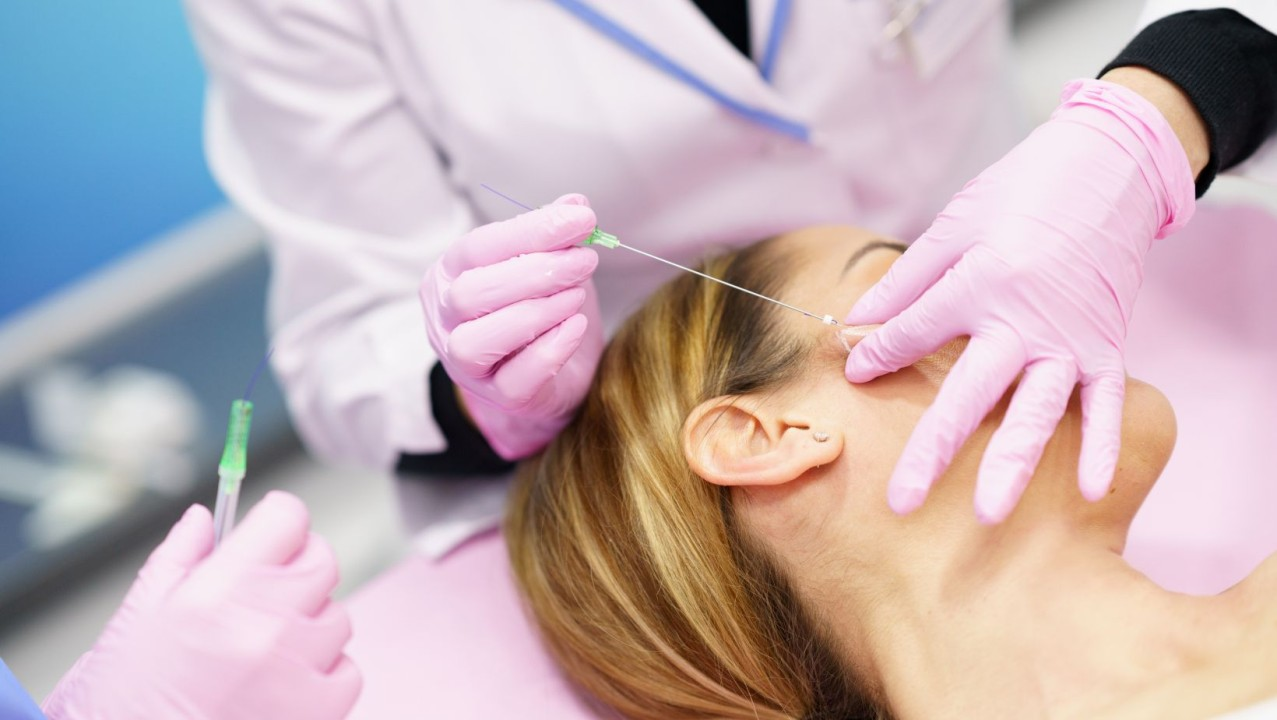
Accurate thread direction and facial assessment by an experienced physician are essential for natural-looking, balanced results.
3. Infection or Inflammation
Mild swelling is common for the first 3–4 days, then it should gradually subside within 14 days. However, if swelling worsens, turns red, or becomes painful after day 4, patients should return to the clinic for evaluation and antibiotic treatment.
4. Blood Swelling (Hematoma) or Fluid Swelling (Edema)
Thread insertion involves needles, so swelling is a natural response. There are two main types:
- Hematoma: Bleeding under the skin
- Edema: Fluid retention caused by inflammation
Both usually resolve on their own within 2–3 weeks and are not harmful. The type of needle used also influences the degree of swelling.
Types of Needles Used in Thread Lifting
Thread lifting involves various types of needles and threads, each with its own characteristics and purpose. Below are the most common types of needles used in thread lifting, explained step-by-step:
Examples of Thread Lift Needle Types
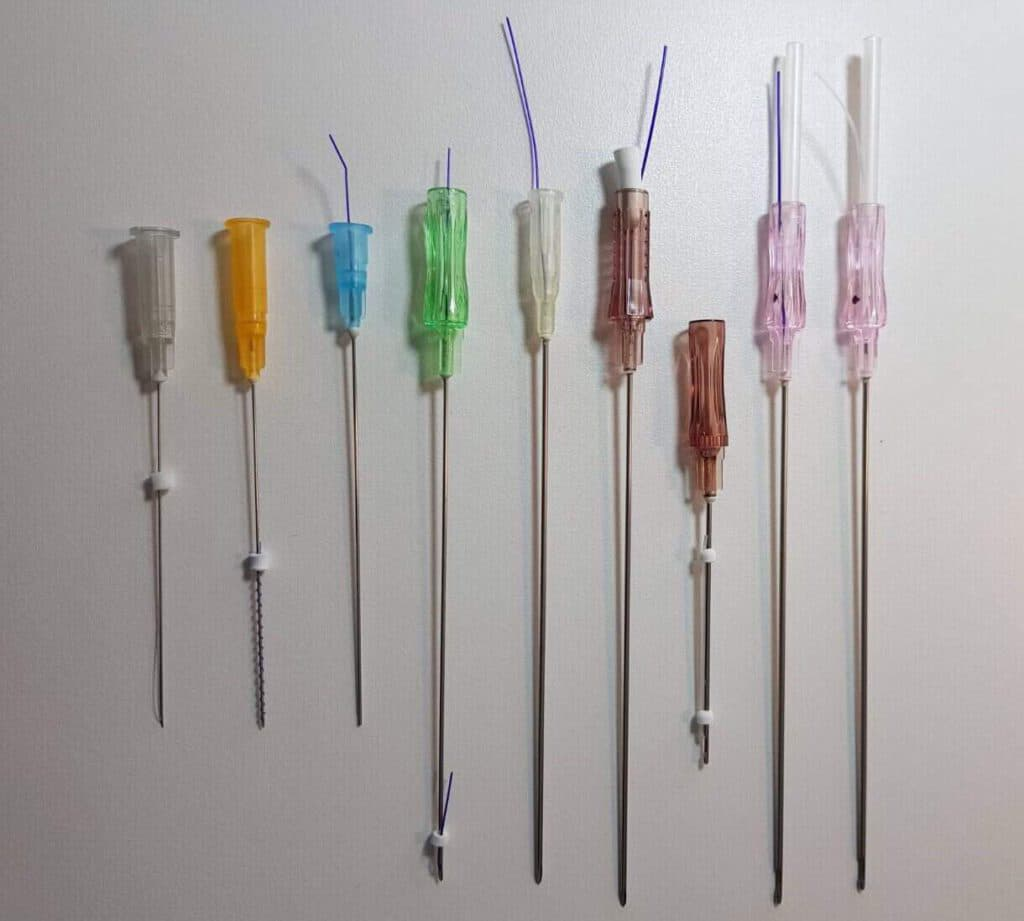
Sharp-Tip Needle — Higher Risk of Hematoma than Edema
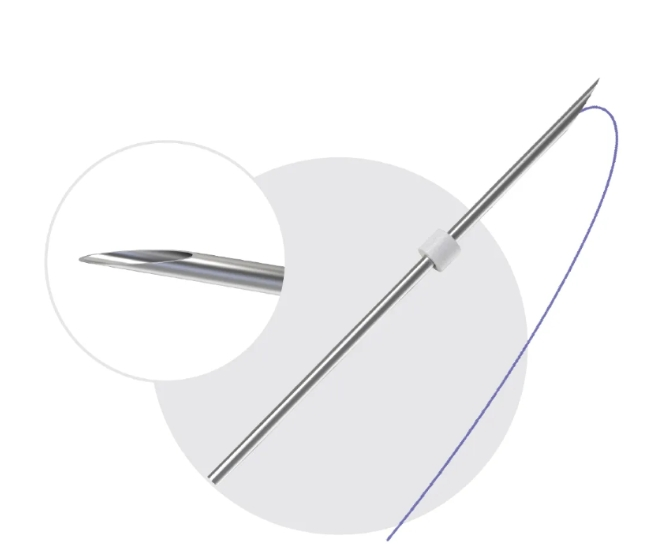
Thread lifting using sharp-tip needles cuts through tissue similarly to a fine surgical blade. This approach often results in less pain and minimal fluid retention, as small blood vessels heal quickly.
However, if the needle hits a larger vessel, it may cause bruising or hematoma, so precision and the experience of the physician are key.
Blunt-Tip Needle — Higher Risk of Edema and Possible Bruising
It passes through the tissue by tearing, similar to cutting with a dull knife. This causes more pain and swelling (edema) than sharp needles. While it can avoid major blood vessels, small capillaries may still tear, causing minor bleeding. The blunt needles used for thread lifting are larger than those used for filler injections, resulting in more swelling and bruising than fillers.

For filler injections, using a sharp needle may give more precise and aesthetically pleasing results, but it carries a higher risk of injecting into blood vessels. Therefore, blunt needles are typically used for fillers.
However, in thread lifting, some physicians prefer sharp needles because they offer better precision and control during the procedure.
Cutting Needle — Semi-Blunt, Semi-Sharp

The tip of a cutting needle resembles a hollow tube. It is sharper than a blunt cannula, but less sharp than a true sharp-tip needle.
L-Type Needle — Enhanced from Cutting Needle
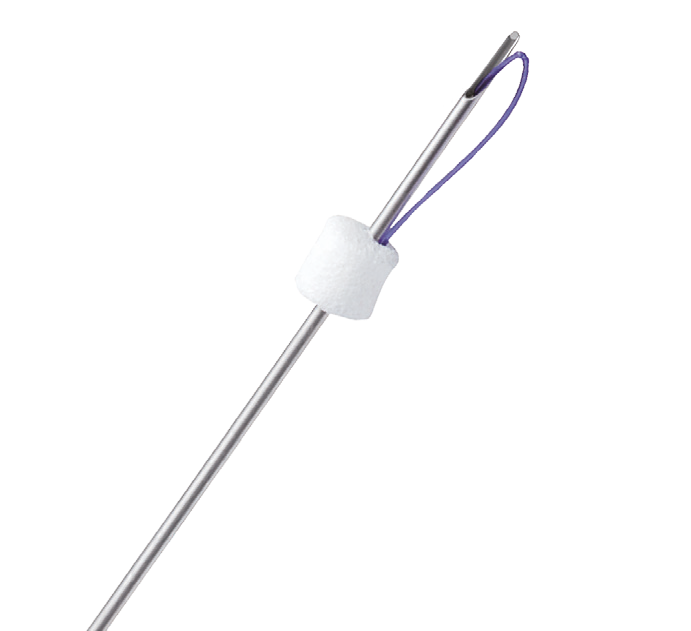
The L-type needle is an improved version of the cutting needle. It enhances both safety and lifting precision, helping reduce swelling and bruising after the procedure.
Overall, there is no single “best” needle type. The optimal choice depends on the patient’s tissue characteristics and the doctor’s technique.
For example, in patients with past acne and fibrotic skin, sharp needles may cause less bruising than blunt ones.
At V Square Clinic, all needle types are available. Our physician will assess your skin condition and select the most appropriate option based on your individual needs.
Why Do Thread Lift Results Seem to Fade After 3–4 Months?
3 key factors influence how long thread lift results last.
1. Elastin Quality in the Patient’s Skin
Barbed threads hook into soft tissue to provide lift, much like a tiny anchor.
However, if the tissue is aged or weakened, the thread barbs may lose grip before the thread dissolves. This causes the skin to detach from the thread prematurely.
On average, elastin in our skin holds its structure for around 6 months. If the skin is loose or the underlying elastin is poor, the lifting effect may not last as long, even if the thread itself is still intact.
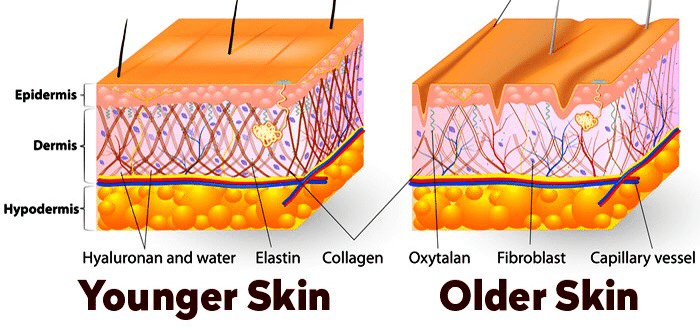
Thread lifting in older individuals tends to yield shorter-lasting results because their skin lacks elastin. However, repeated thread lifting sessions can enhance longevity by stimulating elastin production over time.
2. Elastin Production
Even after the threads dissolve, if elastin is sufficiently produced in the skin (like a glue-like binding effect), firmness can still be maintained.
3. Thread Longevity
Each thread material dissolves at a different rate. The 3 most commonly used are:

- PCL (Polycaprolactone) – Fully dissolves in 12 months. Opaque white threads with the highest flexibility and the thickest diameter.
- PLLA (Polylactic Acid) – Fully dissolves in 12 months. Clear white threads, less flexible, with a higher risk of thread breakage or extrusion.
- PDO (Polydioxanone) – Fully dissolves within 4–8 months. Blue threads with high flexibility. Most widely used due to its reliability and effectiveness.
Which Type of Thread Lift Is the Best?
Many clinics promote thread names like Rose Thread, Piranha Thread, Ruby Thread, or Tornado Thread. However, these names are not internationally standardized—they are created to make price comparisons more difficult.
Instead of focusing on thread names, patients can ask the clinic directly about the thread type used. Threads can be categorized in two ways:
- By material: PDO, PLLA, or PCL
- By structure/design

In the image shown:
- PDO is blue
- PLLA is clear white
- PCL is milky white
From experience, larger barbed threads (regardless of name) tend to provide the most effective lifting results. These are used widely across clinics, though marketed under different names and pricing strategies.
Before and After Care for Thread Lifting: How to Maximize Results
Before the Procedure
- Consult your physician to assess your facial structure and specific concerns.
- Disclose any history of allergies, medications, or supplements (especially aspirin, NSAIDs, ginseng, or vitamin E).
- Avoid alcohol and strenuous activities for 24 hours before treatment.
- Local anesthesia will be administered before the thread lift begins.
Aftercare Instructions
- Avoid scratching, pressing, or massaging the treated area. Swelling, redness, or bruising at the thread insertion points is normal and typically subsides in 2–3 days.
- Take anti-inflammatory or pain-relief medication as prescribed by your physician.
- Avoid excessive facial movement for the first 3 days to prevent thread displacement.
- Refrain from laser treatments, radiofrequency, or other heat-based procedures for at least 2 months.
To ensure the best results and longer-lasting effects, it is essential to follow your physician’s advice strictly, particularly avoiding heat-related treatments, alcohol, and unnecessary facial contact.
How Much Does a Thread Lift Cost?
The cost of a thread lift depends on the thread type, material, and the number of threads used during treatment. At V Square Clinic, pricing starts at approximately 8,900 THB. Only high-quality PDO and PCL threads are used—each certified by the FDA in Thailand and internationally—ensuring a safe and effective procedure.
Interested in thread lifting at V Square Clinic ?
Click to see our latest promotions.

How Many Threads Are Needed for a Full-Face Thread Lift?
The number of threads used for a full-face thread lift depends on the individual’s facial structure. A physician will first assess the patient’s face before proceeding. Typically, patients with sagging skin may need 3 to 10 threads per side, based on these 3 main factors: the volume of facial fat, skin density, and the areas that need lifting.
Is There a Difference Between 10 and 20 Thread Lifts?
Using more threads increases lifting strength and helps prolong the results.
For patients with significant cheek sagging, lifting and firming the area to achieve long-lasting results often requires stronger threads and a larger number of threads.
Therefore, using 20 PDO threads provides noticeably better results compared to using only 10 threads. However, the ideal number of threads should be carefully assessed based on individual facial structure and treatment goals.
Thread Lift Reviews – Real Results from Real Patients
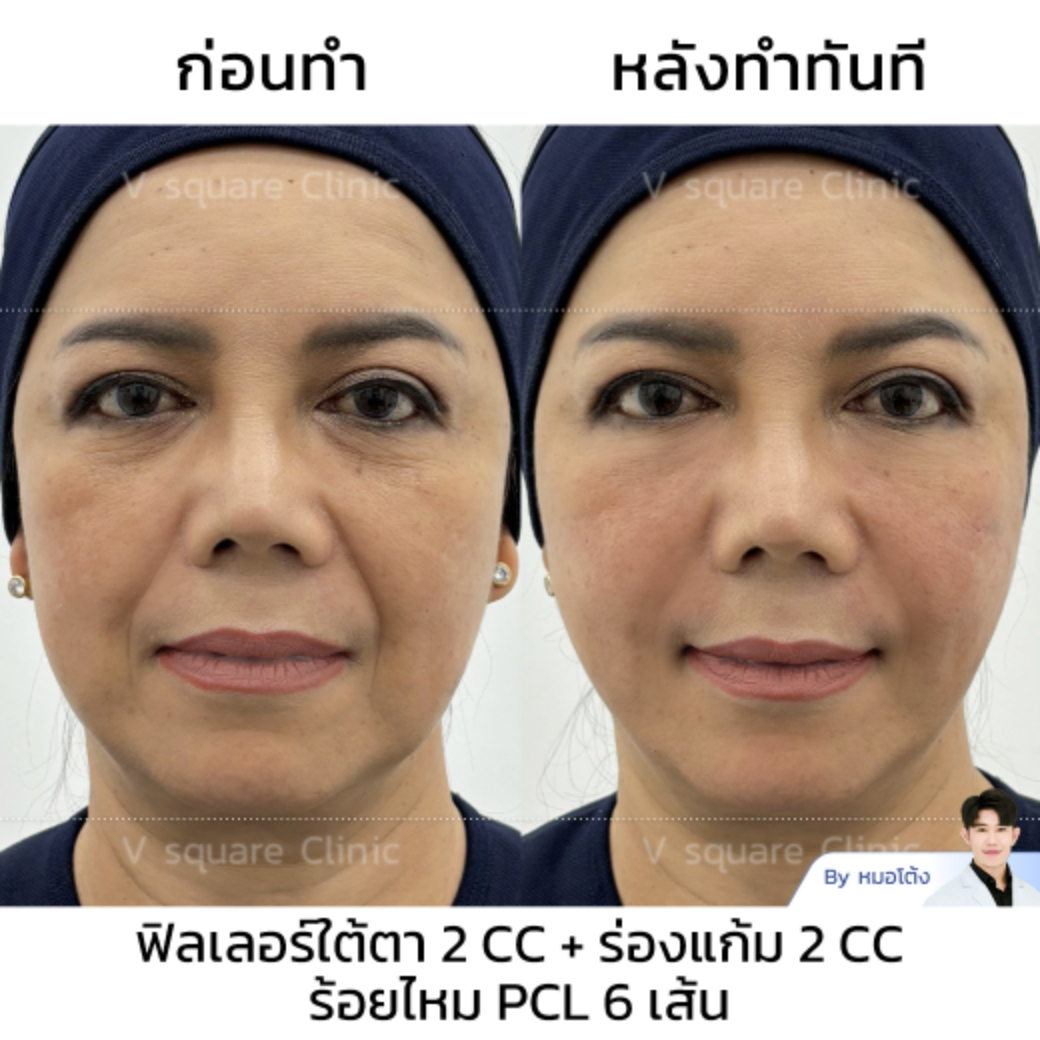
Under-Eye Filler 2 CC + Nasolabial Fold Filler 2 CC +PCL thread lift 6 threads
*Results may vary depending on the individual
In this case, the patient had concerns with sagging cheeks, deep nasolabial folds, and hollow, dark under-eyes that contributed to a tired appearance. After undergoing a thread lift, combined with filler injections under the eyes and in the nasolabial folds, the results were visible immediately. The folds became less noticeable, the under-eye area appeared brighter, and the overall face looked significantly more youthful.
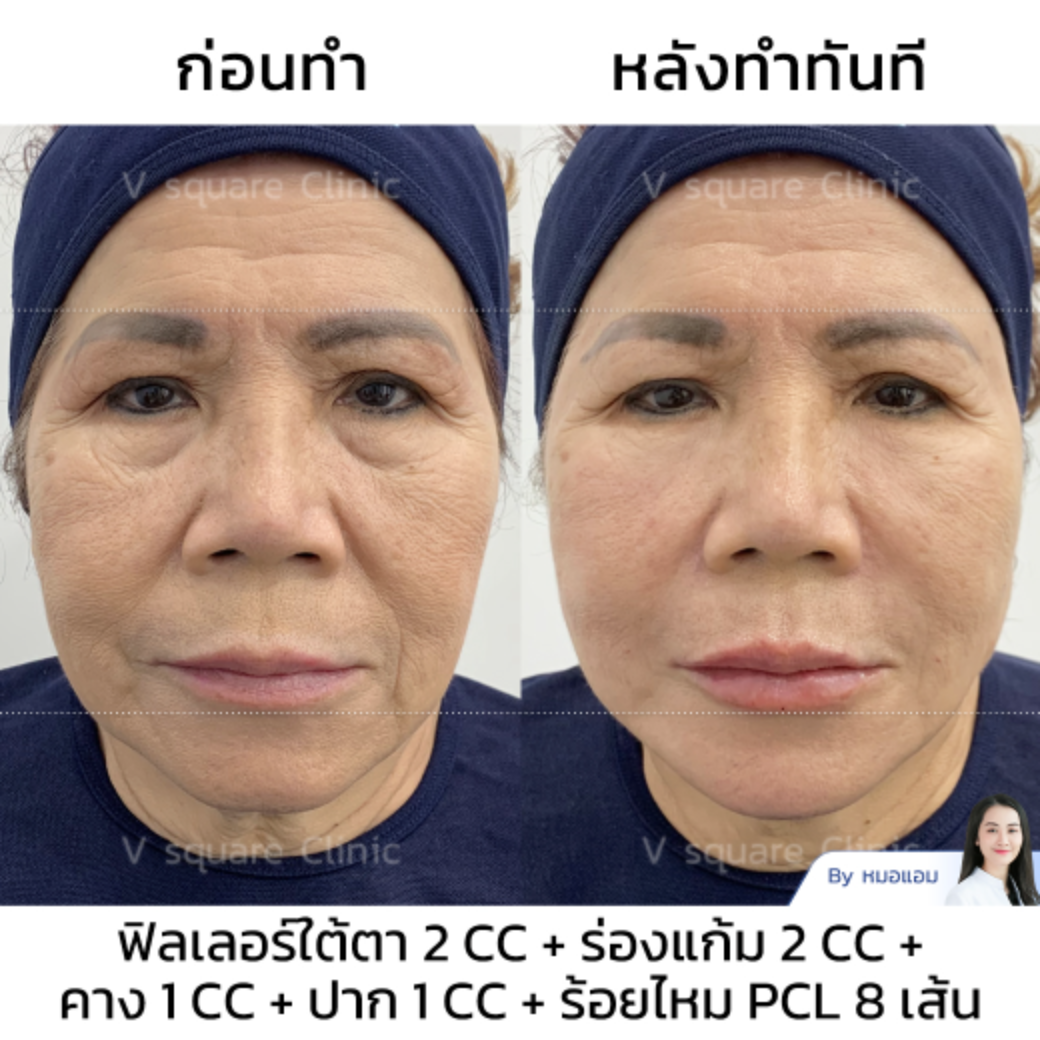
Under-eye filler 2 CC + Nasolabial fold filler 2 CC + Chin filler 1 CC + Lip filler 1 CC + PCL thread lift 8 threads
*Results may vary from person to person
Before the procedure, this patient had issues with facial sagging, deep nasolabial folds, under-eye lines, and hollow tear troughs.
Immediately after treatment, the face appeared noticeably firmer and lifted, with a more contoured V-shape. The under-eye area looked fuller and rejuvenated.
Thread Lifting — Frequently Asked Questions
How long does it take to see results after a thread lift?
You will notice an immediate lifting effect right after the procedure. However, full results become more defined and natural-looking after about 1 month. If there is any swelling, it usually subsides within 14 days.
Is thread lifting painful?
No, thread lifting is generally not painful. A local anesthetic is administered before the procedure. You may feel mild pressure during thread insertion, which is completely normal.
Do I need anesthesia for thread lifting?
Yes. Thread lifting always requires local anesthesia. The treatment area is thoroughly cleaned and numbed to ensure patient comfort during the procedure.
How long does the procedure take?
The procedure usually takes 45 to 60 minutes, depending on the number of threads used and the physician’s technique.
If I don’t get thread lifts regularly, will my face sag more?
No, that’s a common myth. Once the threads dissolve, they stimulate natural collagen and elastin production. If the technique is done correctly, your skin will remain firmer than it was before the treatment.
Can thread lifting correct facial asymmetry?
Yes, it can. In cases where one side of the face appears more saggy or uneven, threads can be placed with differing tension on each side. The physician will use a stronger lifting force on the more sagging side to restore facial balance.
Summary: Thread Lifting for a Slimmer, Firmer Face with Instant Results
Thread lifting is a safe, effective, and fast-acting aesthetic procedure. It helps correct issues such as sagging cheeks, loose skin, undefined jawline, drooping brows, and even allows for non-surgical nose enhancement.
At V Square Clinic, our physicians are highly experienced in facial contouring and have completed advanced training in thread lift techniques, including:
- Thread Lift Training
- Advanced Thread Lifting
- Hands-on Barbed Thread Lift Rejuvenation (both locally and internationally)
We thoroughly evaluate each patient’s facial structure and customize the number and type of threads for optimal results. You can feel confident in receiving results that are both beautiful and safe.
Reference
- Cosmetic Surgery Today, Threadlift, 2012. (Access October 30, 2012, at http://www.cosmeticsurgerytoday.com/threadlift /)
- American academy of aesthetic medicine: hands-on Korean thread lifting master course. http://cbbmed.com/newsview.php?title=Different_PDO_Threads_in_Thread_Lifting&id=19
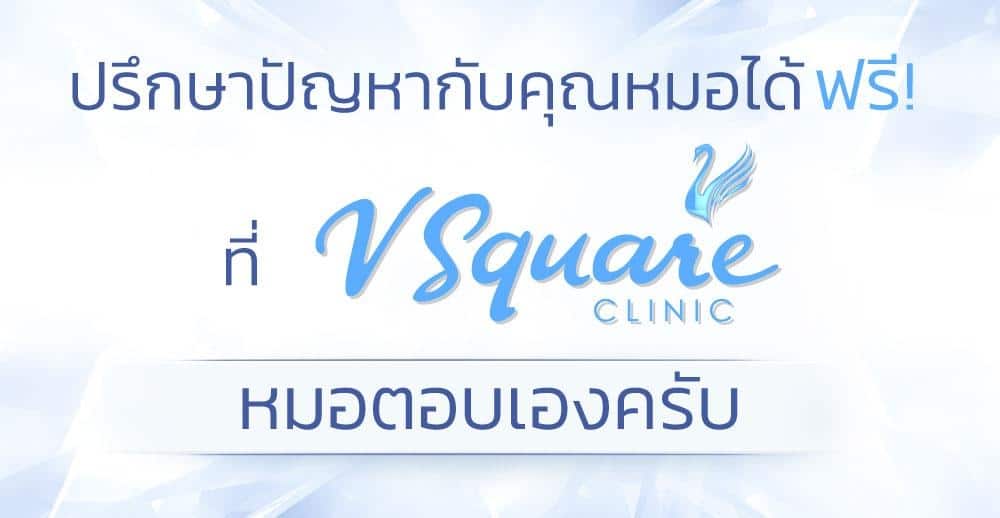
สำหรับผู้อ่านทุกท่านที่มีข้อสงสัยเพิ่มเติม ทีมแพทย์ V Square Clinic ทุกคนยินดีให้คำปรึกษาฟรี โดยไม่มีค่าใช้จ่าย หรือสามารถปรึกษาหมอทาง inbox facebook หรือ Line นี้ได้เลยครับ หมอตอบเองครับ



